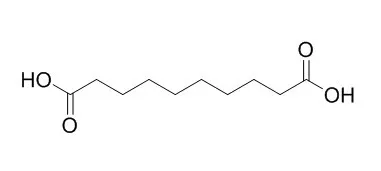| Structure Identification: |
| AAPS PharmSciTech. 2014 Feb;15(1):111-20. | | Identification of unknown impurity of azelaic acid in liposomal formulation assessed by HPLC-ELSD, GC-FID, and GC-MS.[Pubmed: 24166667] | The identification of new contaminants is critical in the development of new medicinal products. Many impurities, such as pentanedioic acid, hexanedioic acid, heptanedioic acid, octanedioic acid, Decanedioic acid, unDecanedioic acid, doDecanedioic acid, triDecanedioic acid, and tetraDecanedioic acid, have been identified in samples of azelaic acid.
METHODS AND RESULTS:
The aim of this study was to identify impurities observed during the stability tests of a new liposomal dosage form of azelaic acid that is composed of phosphatidylcholine and a mixture of ethyl alcohol and water, using high-performance liquid chromatography with evaporative light-scattering detector (HPLC-ELSD), gas chromatography-flame ionisation detection (GC-FID), and gas chromatography-mass spectrometry (GC-MS) methods. During the research and development of a new liposomal formulation of azelaic acid, we developed a method for determining the contamination of azelaic acid using HPLC-ELSD. During our analytical tests, we identified a previously unknown impurity of a liposomal preparation of azelaic acid that appeared in the liposomal formulation of azelaic acid during preliminary stability studies. The procedure led to the conclusion that the impurity was caused by the reaction of azelaic acid with one of the excipients that was applied in the product. The impurity was finally identified as an ethyl monoester of azelaic acid.
CONCLUSIONS:
The identification procedure of this compound was carried out in a series of experiments comparing the chromatograms that were obtained via the following chromatographic methods: HPLC-ELSD, GC-FID, and GC-MS. The final identification of the compound was carried out by GC with MS. |
|






 Cell. 2018 Jan 11;172(1-2):249-261.e12. doi: 10.1016/j.cell.2017.12.019.IF=36.216(2019)
Cell. 2018 Jan 11;172(1-2):249-261.e12. doi: 10.1016/j.cell.2017.12.019.IF=36.216(2019) Cell Metab. 2020 Mar 3;31(3):534-548.e5. doi: 10.1016/j.cmet.2020.01.002.IF=22.415(2019)
Cell Metab. 2020 Mar 3;31(3):534-548.e5. doi: 10.1016/j.cmet.2020.01.002.IF=22.415(2019) Mol Cell. 2017 Nov 16;68(4):673-685.e6. doi: 10.1016/j.molcel.2017.10.022.IF=14.548(2019)
Mol Cell. 2017 Nov 16;68(4):673-685.e6. doi: 10.1016/j.molcel.2017.10.022.IF=14.548(2019)